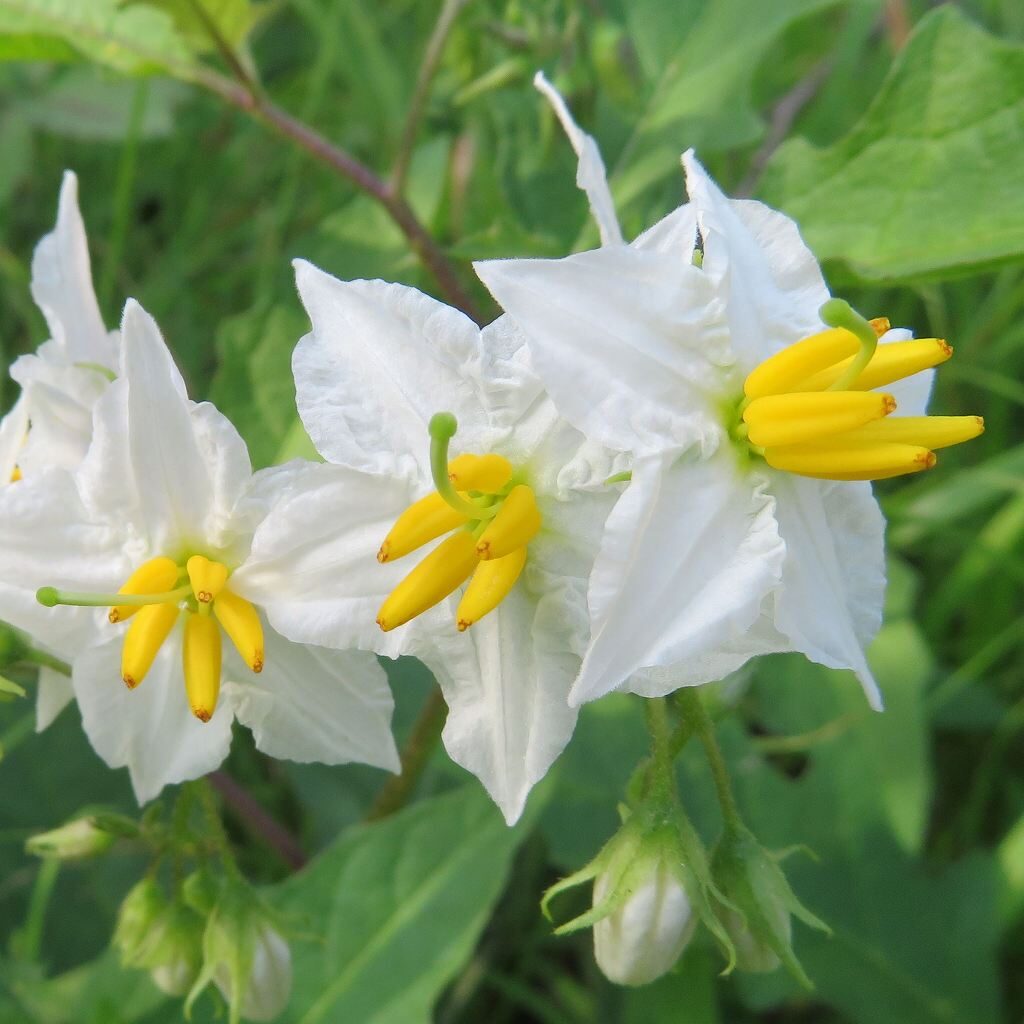ワルナスビの名前の由来は、花が茄子に似ていて、茎葉に棘があり、果実が毒を含むから。農耕地に侵入されると駆除が難しい帰化雑草です。
The Bad Eggplant: Japanese name of Carolina Horsenettle comes from the fact that the flower resembles an eggplant, the stems and leaves have spines, and the fruit contains poison. It is a naturalized weed that is difficult to eradicate once it invades agricultural land.
【仮名】ワルナスビ
【和名】悪茄子
【英名】Carolina Horsenettle
【学名】Solanum carolinense
【誕生】08/ 28, 11/ 21
【開花】06, 07, 08月
【花色】White



ワルナスビ
ワルナスビの拡大
ワルナスビはナス科の多年草。原産地は米国南東部のカロライナ周辺です。全世界に分布が拡大し、日本でも北海道から沖縄まで自生。根茎を縦横に伸ばし、農耕地にも侵入します。駆除しようとして鋤き込むと千切れた根茎から次々再生。かえって殖えてしまう厄介な帰化雑草です。
ワルナスビの名前
ワルナスビの名前の由来は、花が茄子に似ていて、茎葉に棘があり、果実が毒を含むからです。1906年に千葉県成田市の御料牧場で牧野富太郎博士が発見し、命名。農耕地に侵入されると駆除が難しく、「ソドムのリンゴ」「悪魔のトマト」などの英名もあります。花言葉も「悪戯」。
ワルナスビの姿形
ワルナスビの茎は、たくさん枝分かれし、節ごとに「くの字」に屈曲。そして茎だけでなく、葉柄や葉裏の葉脈にまで鋭く硬い棘が生えます。葉は互生し、長楕円形。縁には大きな切れ込みが入ります。花は星形の花冠が浅く5裂して皿状に展開。花後に黄色い球形の液果を結びます。
ワルナスビの問題
ワルナスビは要注意外来生物。全草に毒性のあるソラニンを含むため、果実も食べられません。家畜が放牧地で誤食し、中毒死することも。生えているのが農耕地の外であっても、ニジュウヤホシテントウなどの害虫を殖やし、同じナス科のジャガイモなどに作物被害をもたらします。
Carolina Horsenettle
Carolina Horsenettle is a perennial herb of the Solanaceae family. It is native to the Carolina area of the southeastern United States. Its distribution has spread all over the world, and even in Japan it grows naturally from Hokkaido to Okinawa. It extends its rhizomes vertically and horizontally and invades farmlands. When plowed in to exterminate, it regenerates one after another from torn rhizomes. It’s a troublesome naturalized weed that will grow on the contrary.
The Bad Eggplant: Japanese name of Carolina Horsenettle comes from the fact that the flower resembles an eggplant, the stems and leaves have spines, and the fruit contains poison. It was discovered in 1906 by Dr. Tomitaro Makino at the royal ranch in Narita City, Chiba Prefecture, and named it. It is difficult to get rid of when it invades agricultural land, and has English names such as “Apple of Sodom” and “Devil’s Tomato”. Flower language is also “mischief”.
The stem of Carolina Horsenettle has many branches, and each node bends into a “dogleg” shape. Sharp and hard spines grow not only on the stems, but also on the petioles and veins on the underside of the leaves. The leaves are alternate and oblong. There is a large notch on the edge. The flower has a star-shaped corolla that is shallowly 5-lobed and spreads out like a dish. After flowering, it produces yellow spherical berries.
Carolina Horsenettle is a foreign species that needs attention. The fruit is inedible because the whole plant contains solanine, which is toxic. Livestock may accidentally ingest it on pasture and die of poisoning. Even if it grows outside of agricultural lands, it spreads pests such as the ladybird beetle and causes crop damage to other members of the Solanaceae family, such as potatoes.


